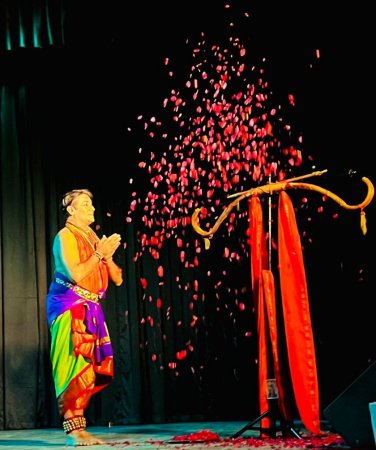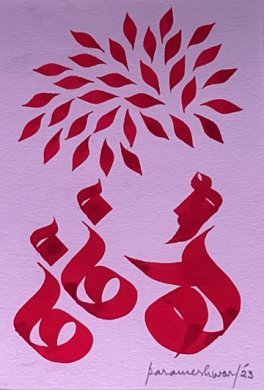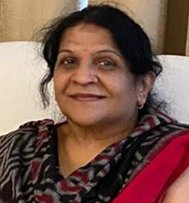
|   |

|   |
Epic in a nutshell - Ranee Kumar e-mail: Ranee@journalist.com July 13, 2023 There are two ways of looking at an epic (Itihasa or Purana) being retold- not just the exploration of a single unique persona, entity or episode, but the entire story from start to finish. At times it can be dubbed as jaded or hackneyed having been dealt with by different artistes across centuries through different mediums. Or it can be complimented as a narrative retold with artistic excellence. Whatever it be, Rama Katha (story of Rama/Ramayana) is now in vogue. And Satyanarayana Raju's artistic endeavour had already earned its laurels when it was premiered years ago.  Satyanarayana Raju His Ramayana was so brilliantly weaved into an hour and half solo Bharatanatyam that it took the audience by storm. For one who was viewing it a third time, it still could evoke an emotional response and sustain an unwavering interest. The music and the keertana / kriti (lyrics) were par excellence. The subtle props the artiste took recourse to, lent the dramatic element to the dance and went well with a non-dance literate audience. The highlight was quick succession of scenes spurring the narrative's progress as also choice of episodes that linked the story without missing out on the sequence of events, making for a wholesome treat. It was not just a story retold. It was also the delineation of certain key characters who contributed to the development of the theme, in this case the Ramayana itself. Raju sculpted these personae with his inimitable emotive artistry making each of them memorable to the viewer. Of these, the crooked Manthara, the tormentor whose vile design triggers the series of events which go beyond human control, is a sort of prime mover. Raju prods around the stage enacting the crippled old hag who poisons the mind of the queen Kaikeyi just prior to Rama's coronation - a very important episode, in fact the seed that is sown for the entire Ramayana story. In a startling second, the artiste drives home the point that spurs the juggernaut of unbelievable troubles for the heir apparent, eldest born of king of Ayodhya. The donning of a piece of cloth as a saree to depict a woman was undertaken with fleeting agility, in a most commendable manner. Next comes Guha, the humble boatman who ferries Rama, Sita and Lakshmana across the river towards the forests for the mandatory 14-year exile. Guha represents movement of life across time and space into unchartered seas. The agility with which Raju depicted Guha rowing the boat was impressive to say the least. Of all other characters, it was Jatayu (eagle) that was the dancer's masterpiece enactment. Right from flapping of the huge wings of the bird to the agony on one wing being chopped off and the emotion therein to stay alive to narrate to Rama the abduction of his beloved wife, every little detail was portrayed with a sensitivity and grace. The string of syllabic utterances only enhanced the poignant scene where the huge bird is depicted as falling to the ground on being wounded. Shabari and Hanuman, of course well-chiselled characters suffused with devotion, each in their own manner were executed with finesse. The Kannada song with its lilting music and meaning aptly unfolded Shabari's devotion and undying love and wait for Rama. Hanuman, on the other hand has become a much beaten character and so it goes without saying that there wasn't anything unique in his portrayal except the usual simian gait, the devotional joy of identifying Sita in Lanka and so on. Not to be overlooked was depiction of entire Bala Khanda through the melodic Tumak chalat Ramachandra... a picture perfect portrayal of child Rama, a bashful Sita, an obedient brother, an insensible step-mother and a heart-broken father. Raju's dancing abilities have not been dented by age or seniority. He is an agile and stylish dancer whose footwork is graceful without being effeminate, with an ease and Úlan that bear testimony to his experience. Wish he interspersed all episodes with footwork execution, giving it equal importance along with abhinaya. There is always a defence mounted for this statement, that the scenes get enhanced with expressive gestures rather than pure nritta. But in classical art form, one cannot afford to minimize either, as a rule. Take for instance, a Carnatic classical kutcheri. Will the rasikas appreciate an emotionally rendered song devoid of the frills of swarakalpana, neraval and such others? It ceases to be classical in the strict sense of the term. Raju compensated this in his Ramayana by winding it up with a Tillana which gave him ample scope to showcase his skill with pure dance.    The pictorial calligraphy by Parameshwar Raju corresponding to the dance theme and episodes was excellent. There was an interactive session in the morning with the calligraphy artist and schoolchildren. Kudos to Sanskar Bharati of Dehradun and Dr. R.K. Usha for putting up this beautiful Rama Chitra Katha show.  Ranee Kumar is a journalist who brings in three decades of hard core journalistic experience with.mainstream papers like the Indian Express and The Hindu to arts reporting. Her novel 'Song of Silence' and guest editing of attenDance widen her horizon. |